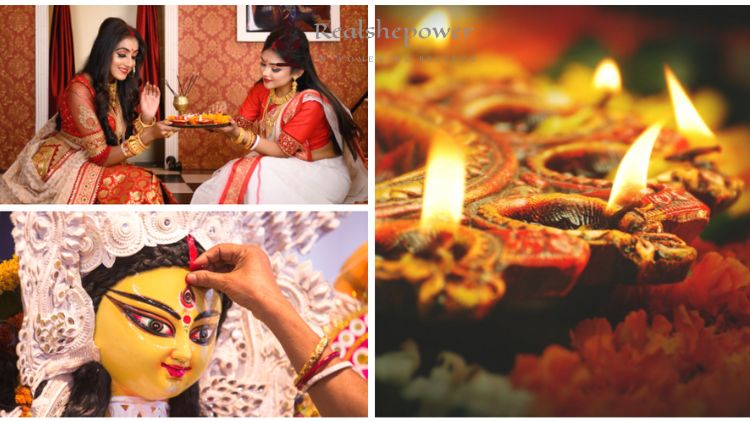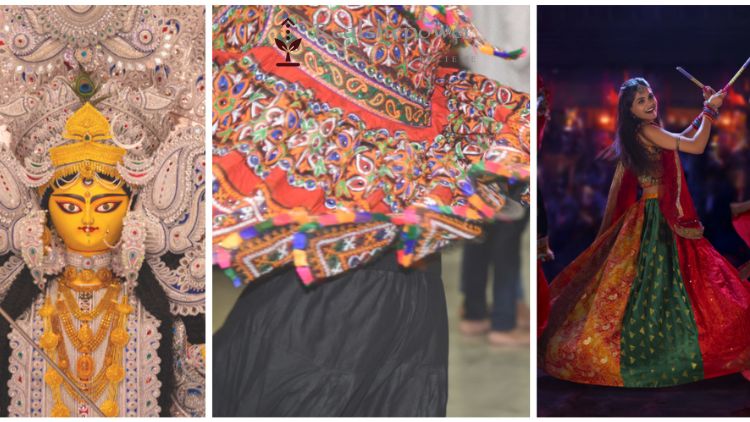Navratri 2023: The 9 Nights of Divine Feminine Power & Ancient Mysteries!


As the festive air brims with anticipation and excitement, Indian women from every corner of the nation eagerly await Navratri 2023, a festival of divine feminine power, spiritual renewal, and cultural vibrancy. Every year, the nine auspicious nights of Navratri weave together a rich tapestry of religious symbolism, ancient history, and stirring stories that resonate deeply with millions. Let’s delve into this magnificent celebration, tracing its roots and understanding its multifaceted significance.
Table of Contents
The Divine Feminine Unleashed
Navratri stands as a testament to the power and grace of the divine feminine, epitomized in the nine diverse forms of Goddess Durga. Each night of this grand festival is dedicated to celebrating and invoking a unique manifestation of the Goddess, inviting her blessings and protection. It’s more than a ritual; it’s an experiential journey that allows women across India to deeply connect with the facets of their own inner strength, resilience, and grace, paralleling the virtues of the divine feminine.
– A Symphony of Nine Nights
The festival unfolds as a symphony where each night serenades a different note, a distinct energy that the Goddess embodies. The first night sees the worship of Shailaputri, a form representing the peaks of the mountains, the strength that is both majestic and unwavering. As the nights progress, women engage in the spiritual dance of celebrating forms like Brahmacharini, symbolizing penance; Chandraghanta, the embodiment of serenity and peace; and Kushmanda, who is believed to have created the universe with her divine smile.
– The Mirror of Self-Reflection
For the contemporary Indian woman, these nine nights become a mirror reflecting the multifaceted nature of her own existence. Every avatar of Durga resonates with the various roles women play in their lives, from caregivers and professionals to nurturers and warriors. It’s an affirmation that within every woman lies an unyielding strength and an undying grace, akin to the Goddess.
– Embracing Inner Power
The essence of the Goddess is not just to be worshipped but to be realized within oneself. The nights of prayer, song, and dance are not mere rituals but pathways leading to an inner sanctuary where the divine feminine resides in every woman. In a world where women often juggle multiple responsibilities, facing numerous challenges, the divine feminine becomes a source of strength, an inner reservoir of energy, resilience, and wisdom.
Read: 10 Incredible temples in India with Rich History and Spectacular Aura
– A Journey into the Sacred Feminine
Navratri is the time when this inner sanctuary is opened, the sacred feminine within is honored, and every space, from the confines of the home to the expanse of temples, becomes sacred ground. Women, adorned in traditional attire, their spirits as vibrant as the colors they wear, find themselves in a space where the worldly and the divine intersect.
The Historical Landscape
One of the most prominent historical anchors of Navratri lies in the heart of the great Indian epics, the Mahabharata and Ramayana. In the tapestry of the Mahabharata, the celebration of good over evil is poignantly encapsulated, echoing the spiritual ethos of Navratri. The characters of this grand narrative, their trials, triumphs, and tribulations, weave a subtle yet profound connection to the nine nights of divine celebration.
The Ramayana, another cornerstone of Indian spiritual literature, too, entwines its essence with the soul of Navratri. The victory of Lord Rama over the demon king Ravana is often commemorated during this festival, symbolizing the eternal triumph of light over darkness, virtue over vice, and good over evil. This grand narrative, replete with its mystical characters, divine interventions, and moral lessons, adds a layer of depth, richness, and spiritual intensity to Navratri’s celebrations.
Furthermore, regional variations of Navratri celebrations offer a glimpse into the multifaceted historical landscape of this festival. In the east, the narrative might be adorned with the tales of Durga’s victory over Mahishasura, while in the north, the echoes of Rama’s divine prowess might dominate the spiritual air. Each regional narrative, while rooted in the core ethos of Navratri, offers a unique, colorful, and enriching addition to the historical landscape of this festival.
A Festival of Diverse Colors
Navratri isn’t just celebrated with fervent prayers and rhythmic dances; it’s also a visual spectacle where each day is painted with a specific color, symbolizing a unique avatar of Goddess Durga. These colors are not randomly chosen; they are deeply rooted in ancient symbolism and religious significance, each representing a distinct energy and attribute of the divine feminine.
A Colorful Tradition Rooted in Symbolism
On the first day of Navratri, for example, you may see a sea of devotees adorned in vibrant red, echoing the vigor and sensuality of the goddess. Red, often associated with the powerful Goddess Kali, symbolizes action and vigour. It’s a color that’s as commanding as it is captivating, setting the tone for the nine nights of spiritual and cultural revelry.
As the days progress, the palette transforms. Blue represents the divine energy of tranquility and serenity. Yellow, illuminating the surroundings with its bright hue, epitomizes joy and happiness. Green marks nature’s abundance and the goddess’s nurturing aspect. Each color, a symbol, each day, a narrative of the goddess’s multifaceted nature.
Related Article: The Land of Fortune: India
The Vibrancy Extends Beyond Attires
The colorful celebration isn’t restricted to clothing. The adornments, decorations, and offerings mirror the daily color, creating an environment where every element is in harmonious synchronization with the spiritual vibration of the specific form of the goddess being worshipped.
Dance, Music, and Celebrations

Garba: The Dance of Devotion
Garba, a traditional dance form, is central to Navratri celebrations. Women, adorned in colorful chaniya cholis and ornate jewelry, form circles representing the cyclic nature of life and dance to the rhythmic beats and melodious tunes that fill the air. The dance’s evolving circles and spirals are symbolic of the cosmos’ eternal motion, and every step taken is an offering of devotion to Goddess Durga.
Dandiya: Sticks that Narrate Tales
Dandiya Raas, another gem in the crown of Navratri celebrations, is characterized by participants clashing sticks in rhythmic harmony. The dance form narrates the playful and divine acts of Lord Krishna and Radha. Amidst the echoing clinks of the dandiya sticks, stories of valor, devotion, and divine love unfold, reflecting the rich cultural and spiritual tapestry of the Indian tradition.
Music: The Soul’s Melody
Music is the soul of Navratri. The air is thick with melodious tunes of devotion, celebration, and joy. Traditional songs narrating the tales of Goddess Durga’s valor and grace intertwine with modern melodies, creating an ambience that transcends time.
Fasting and Feasting
Fasting during Navratri isn’t merely an act of abstaining from food; it’s a sacred practice that signifies the purification of the soul, a voluntary sacrifice aiming to attain spiritual elevation. Many women observe fasts with a dedication that stems from deep-rooted faith, considering it a pathway to connect with the divine energies of Goddess Durga.
The practice of fasting is diverse. Some opt for a nirjal fast, abstaining from both food and water, reflecting an intense form of devotion. Others choose a more moderate path, consuming fruits, nuts, and specific foods like sabudana khichdi or singhare ki puri, designed to sustain the body while maintaining the spiritual sanctity of the fast. Each woman’s approach to fasting is a personalized spiritual journey, reflecting her individual beliefs, health, and devotion.
The Culinary Canvas of Navratri
Contrary to the solemnity of fasting, Navratri also brings a culinary carnival, an extravaganza of flavors, aromas, and delicacies that turn the festival into a gastronomic celebration. Special Navratri thalis, replete with a variety of offerings, make their appearance, honoring the goddess and the festive spirit.
Every region in India adds its unique touch, presenting a culinary tapestry as diverse as the nation itself. In West Bengal, the elaborate bhog for Durga Puja becomes a communal feast. In Gujarat, the nights of dance are complemented by an array of snacks and sweets that energize the celebrants. In the south, varieties of sundal, a dish made of legumes, signify the offering to the goddess.
Stories that Inspire
The Tale of Mahishasura
One of the most compelling narratives associated with Navratri is the story of Mahishasura, a mighty demon with the ability to change forms. He was invincible to men, a boon granted to him due to his ardent devotion to Lord Brahma. Emboldened by his invincibility, Mahishasura’s tyranny knew no bounds. It was then that Goddess Durga, a symbol of divine feminine power and wrath, emerged. She engaged in a fierce battle with Mahishasura for nine grueling days. On the tenth day, she slayed him, symbolizing the eternal triumph of good over evil. Each year, this story is retold, re-enacted, and revered, reminding every listener of the inherent divine power that resides within, waiting to conquer the Mahishasuras of our lives.
Ram’s Victory over Ravana
Navratri also aligns with the narrative of Lord Rama’s victory over Ravana. Rama, the seventh avatar of Vishnu, sought the blessings of Goddess Durga to defeat the mighty demon king Ravana. He worshipped the Goddess for nine days, seeking her power and wisdom, and on the tenth day, armed with divine blessings, he emerged victorious. This narrative underscores the theme of divine intervention and the insurmountable power of good that lies in the heart of the pure and the devoted.
The Relevance for Modern Indian Women
For the contemporary Indian woman, these stories are not just ancient texts but living narratives. They echo the daily battles faced, the triumphs celebrated, and the challenges overcome. They are a reminder that within every woman lies a Durga, a potent force of strength, resilience, and grace, capable of conquering adversities and emerging triumphant.
Each narrative, with its unique characters, intricate plots, and profound morals, is not merely retold but is relived during Navratri. Women across the nation, irrespective of age, find in these stories, fragments of their identity, their struggles, their victories, and their spiritual journeys. They serve as founts of inspiration, illuminating paths, guiding through darkness, and instilling a sense of unyielding power and grace.
Renewal, Revelation, and Reconnection

Also Read: A Letter to Maa Durga
Navratri is a time of spiritual renewal. It is a period marked by fasting, which is not just a physical abstention but a deeper, more meaningful spiritual cleanse. It’s a conscious shedding of accumulated burdens, a deliberate release of energetic blockages, and a systematic purification of the mind, body, and spirit. The rituals, though outwardly symbolic, initiate inward processes of transformation that are both subtle and profound.
A Journey Inward
The chanting of mantras, the offering of prayers, and the lighting of lamps are not mere rituals but pathways leading inward. For Indian women, each night of Navratri becomes a step deeper into the self, a journey into the intricate labyrinths of the soul where fears, hopes, pains, and joys reside. It is a revelation of the self to the self, a meeting with the inner goddess who is as tender as she is fierce, as compassionate as she is invincible.
Navratri – A Soul’s Soiree
As the nine nights culminate, they leave behind not just memories of a cultural and religious extravaganza but imprints of a soul’s soiree with the divine. Indian women emerge from this journey with not just external adornments but with internal embellishments – of insights gained, wisdom acquired, and a spiritual connection renewed.
Durga Mantra (General Prayer):
ॐ सर्वमंगलमांगल्ये शिवे सर्वार्थसाधिके। शरण्ये त्र्यम्बके गौरि नारायणि नमोऽस्तु ते।।
Om Sarva Mangala Mangalye, Shive Sarvartha Sadhike. Sharanye Tryambake Gauri, Narayani Namostute.
Meaning: Salutations to the goddess who is the giver of all good things, to the divine, and to the consort of Lord Shiva. We seek your blessings and refuge.
You can now write for RSP Magazine and be a part of the community. Share your stories and opinions with us here.
